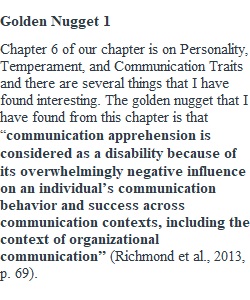


Q ANSWER the following questions: 1. A. Provide ONE golden nugget that you took away from chapter 6, 7, and 8. One golden nugget per chapter. Note: For this assignment, you will be working primarily with Chapter 6, but I am preparing you for work in class, where we will use Chapter 7 and 8. B. For the video on conflict, give ONE specific example that you witness from each section. Specific examples, as in, what did the participants say to make you attach that particular concept? What passage from the section in the chapter made you tie the particular comment/interaction to the concept? A. Communication traits (starting on p. 68) B. Sociocommunicative orientations and styles (starting on p. 73) C. Negative personality traits (starting on p. 77) C. How could empathy be applied in TWO of the situations you watched? What could the participants have said instead of what they did say? Or, where did you see evidence of empathy? Terms and passages from the text should always support your content and should be in bold. 4. Respond to another person's post within 24 hours for an additional five points. You will acknowledge the original poster's words and then add your own thoughts. Your responses will follow the 3CQ format: • Compliment — I like that … or Thank you for sharing ... • Comment — I agree with that, I disagree because … • Connection — I also thought … • Question — I wonder why …
View Related Questions